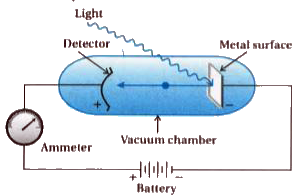What is photoelectric effect ? State the result of photoelectric effect experiment that could not be explained on the basis of laws of classical physics. Explain this effect on the basis of quantum theory of electromagnetic radiations.
Text Solution
Photoelectric effect : When radiation with certain minimum frequency (p0) strike the surface of a metal, the electrons are ejected from the metal surface. This phenomenon is called photoelectric effect. The electrons emitted are called photoelectron

Equipment for studying the photoelectric effect. Light of a particular frequency strikes a clean metal surface inside a vacuum chamber. Electrons are ejected from the metal and are counted by a detector that measures their kinetic energy. The result observed in this experiment were (i) The electrons are ejected from the metal surface as soon as the beam of light strikes the surface, i.e., there is no time lag between the striking of light beam and the ejection of electrons from the metal surface. (ii) The num ber of electrons ejected is proportional to the intensity or brightness of light. (iii) For each metal, there is a characteristic minimum frequency, vQ (also known as threshold frequency) below w hich photoelectric effect is not observed. At a frequency , the ejected electrons come out with certain kinetic energy. The kinetic energies of these electrons increases with the increase of frequency of the light used. The above observation cannot be explained by the electromagnetic wave theory. According to this theory, since radiations were continuous, therefore, it should be possible to accumulate energy on the surface of the metal, irrespective of its frequency and thus, radiations of all frequencies should be able to eject electrons. Similarly, according to this theory, the energy of the electrons ejected should depend upon the intensity of the incident radiation. Particle Nature of Electromagnetic Radiation : To explain the phenom ena of ‘black body radiation’ and ‘photoelectric effect’, Max Planck in 1900, put forward a theory known after his name as Planck.s quantum theory. This theory was further extended by Einstein in 1905. The important points of this theory are as follows : (i) The radiant energy is emitted or absorbed not continuously but discontinuously in the form of small discrete packets of energy. Each such packet of energy is called a ‘quantum’. In case of light, the quantum of energy is called a ‘photon’. (ii) The energy of each quantum is directly proportional to the frequency of the radiation, i.e., E v or E = hv where, h is a proportionality constant, called Planck.s constant, Its value is approximately equal to 6.626×127ergsor6.626×1034 JS. (iii) The total amount of energy emitted or absorbed by a body will be some whole number quanta.
Hence, E = nhv (where, n is any integer),
|
Topper's Solved these Questions
- STRUCTURE OF ATOMBOOK - KUMAR PRAKASHANCHAPTER - STRUCTURE OF ATOMEXERCISE - QUESTINS PAPER FROM MODULE (SECTION -A)
6 Videos
- STRUCTURE OF ATOMBOOK - KUMAR PRAKASHANCHAPTER - STRUCTURE OF ATOMEXERCISE - QUESTINS PAPER FROM MODULE (SECTION -B)
3 Videos
- STRUCTURE OF ATOMBOOK - KUMAR PRAKASHANCHAPTER - STRUCTURE OF ATOMEXERCISE - Section -C(MCQ asked in Board Exam )
53 Videos
- STATES OF MATTER BOOK - KUMAR PRAKASHANCHAPTER - STATES OF MATTER EXERCISE - QUESTION PAPER FROM MODULE (SECTION - A)
4 Videos
- THE P-BLOCK ELEMENTSBOOK - KUMAR PRAKASHANCHAPTER - THE P-BLOCK ELEMENTSEXERCISE - SECTION-D NCERT EXEMPLAR SOLUTION (MCQs) LONG ANSWER
25 Videos
Similar Questions
What is photoelectric effect? State t he result of photoelectric effect experiment that could not be explained on the basis of laws of classical physics. Explain this effect on the b asis of quantum theory of electromagnetic radiations.
View SolutionExplain the concept of photoelectric effect
View Solution
Knowledge Check
Raman effect is explained on the basis of
ACorpuscular theory of lightBElectromagnetic theory of lightCQuantum theory of lightDWave theory of lightThe photoelectric effect can be explained on the basis of
ACorpuscular theoryBWave theoryCelectromagnetic theoryDquantum theoryPhotoelectric effect is explained by
Aclassical theoryBquantum theoryCtheory of special relativityDall of these
What is photoelectric effect ? Explain effect of intensity on photoelectric current.
View SolutionDefine photoelectric effect and state the laws of photoelectric emission.
View SolutionDescribe photoelectric effect and state the laws of photoelectric emission.
View SolutionDescribe photoelectric effect and state the laws of photoelectric emission.
View Solutionthe photoelectric effect can not be explained by the wave theory of light because:
View Solution
